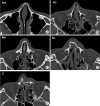Long-term postoperative satisfaction and complications in nasal bone fracture patients according to fracture type, site, and severity
- PMID: 32126614
- PMCID: PMC7054191
- DOI: 10.7181/acfs.2019.00626
Long-term postoperative satisfaction and complications in nasal bone fracture patients according to fracture type, site, and severity
Abstract
Background: It is difficult to completely fix nasal bone fractures with closed reduction, as it is often accompanied by septal cartilage damage, and this often results in postoperative secondary deformities. Thus, patients are often reluctant to undergo closed reduction surgery. The present study aimed to evaluate aesthetic and functional satisfaction, as well as satisfaction with and complications of closed reduction, according to nasal bone fracture type.
Methods: The subjects were patients who underwent closed reduction under general anesthesia from January 2017 to December 2018. Based on the modified Murray classification, patients were classified into five groups according to the fracture site, septal fracture, and deviation. A total of 211 patients were sent a web-based survey on postoperative satisfaction and complications, as well as intention for revision and cosmetic surgery. Sixty-one patients (28.9%) responded.
Results: There were no significant differences in aesthetic and functional satisfaction or satisfaction with closed reduction according to the fracture type, site, or severity. Postoperative functional complications developed in 14 of 61 patients (22.95%). With 10 out of 24 (41.67%) patients (p = 0.044), the bilateral fracture with septal fracture or prominent septal deviation type had a higher incidence of complications than the other types.
Conclusion: The incidence of complications is higher for bilateral fracture with septal fracture or prominent septal deviation compared to the other nasal bone fracture types. Therefore, long-term follow-up after closed reduction surgery for this fracture type can aid in establishing additional postoperative treatment plans and improving patient satisfaction.
Keywords: Bone fractures; Closed fracture reduction; Esthetics; Nasal bone; Postoperative complications.
Conflict of interest statement
No potential conflict of interest relevant to this article was reported.
Figures




References
-
- Rhee SC, Kim YK, Cha JH, Kang SR, Park HS. Septal fracture in simple nasal bone fracture. Plast Reconstr Surg. 2004;113:45–52. - PubMed
-
- Farber SJ, Nguyen DC, Parikh RP, Jang JL, Woo AS. Improving results in closed nasal reduction: a protocol for reducing secondary deformity. Plast Reconstr Surg. 2017;139:51–9. - PubMed
-
- Rohrich RJ, Adams WP., Jr Nasal fracture management: minimizing secondary nasal deformities. Plast Reconstr Surg. 2000;106:266–73. - PubMed
-
- Murray JA, Maran AG. The treatment of nasal injuries by manipulation. J Laryngol Otol. 1980;94:1405–10. - PubMed
Grants and funding
LinkOut - more resources
Full Text Sources

